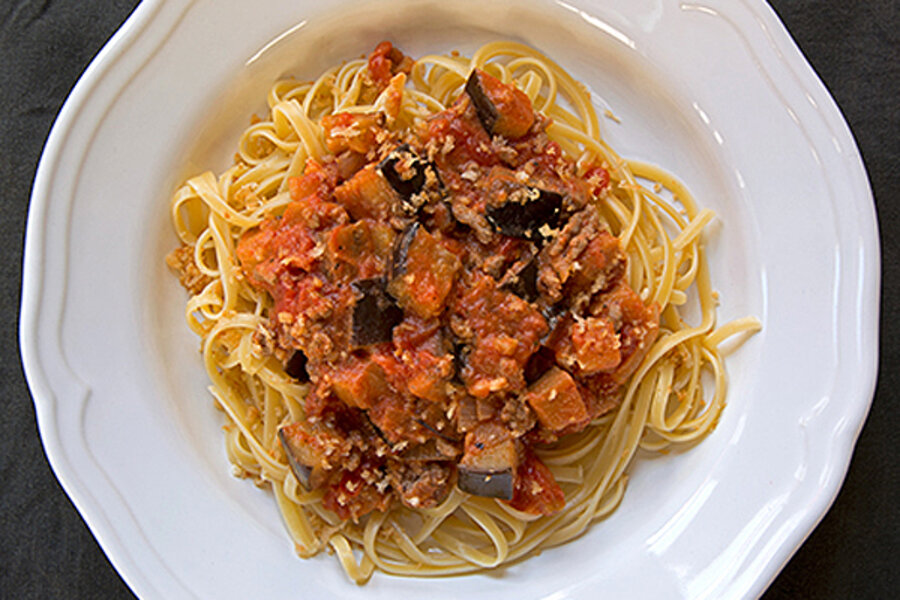Linguine with eggplant and lamb
Loading...
In the 1939 film "Tarzan Finds a Son," when Jane and Tarzan discover a baby in a plane crash, Jane insists that they must name him. The ever practical Tarzan says, “Him strong like elephant. We call him Elephant.” Jane, probably hoping for something more like Colin or Nigel, ultimately has to settle for Boy. Here in the United States, I think the eggplant must have suffered a similarly unimaginative fate: “It shaped like egg. We call it eggplant.”
In France, Britain, and some other places, the eggplant goes by the much more poetic "aubergine," a name it shares with a deep purple color (named for the eggplant’s beautiful dark, shiny skin).
You can’t help but wonder – at least I can’t — if that more colorful name might have made eggplant more popular than it is here. Would seeing aubergine (oh-behr-zheen) on a menu or on the produce shelf make it seem more elegant, more desirable? Naysayers would probably say, well, nay, citing eggplant’s distinctive bitter taste. All the while sipping their bitter coffee and nibbling on bitter dark chocolate.
Done right and in small doses, bitter can be a wonderful flavor note. It is specifically eggplant’s bitter edge that makes classic dishes like eggplant Parmigiana and moussaka such enduring favorites.
To salt or not to salt. One popular method for taming some of the bitterness in eggplant is to salt it a good half hour before cooking to leach out the bitter flavors. Just as many cooks these days, though, say it’s not necessary. Sometimes we do, other times we don’t. The best explanation I’ve found for salting or not salting and what it actually does comes from My Recipes. In essence, salting does make eggplant less bitter, but not because it draws out the bitterness. Salt just makes all bitter things taste less so. Salting does draw out moisture, firming up the eggplant. For dishes like the aforementioned eggplant Parmigiana, that helps the slices hold their shape better.
Also, the bigger the eggplant, the more pronounced the bitterness. For this recipe, I used a medium eggplant, about one pound. I didn’t salt it before hand. The salt in the cooked dish, along with the half and half added at the end, nicely mellowed the eggplant’s bitterness, without causing it to totally lose its distinctive flavor.
Linguine with eggplant and lamb
Serves 4 to 6
1/2 cup Panko or other breadcrumbs
Olive oil
1 28-ounce can peeled whole Italian tomatoes, such as San Marzano
12 ounces ground lamb
Salt and freshly ground black pepper
1 teaspoon dried oregano, divided
1 medium eggplant (about 1 pound), unpeeled, diced into 1/2-inch cubes
1 medium yellow onion, chopped
4 cloves garlic, minced
1/3 cup half and half or cream
12 to 16 ounces uncooked linguine (see Kitchen Notes)
1. Do your prep work. This dish has a number of moving parts, but happens quickly in the end, so get everything ready up front. First, toast the breadcrumbs. In a large nonstick pan, heat 1/2 tablespoon olive oil over a medium flame. Add the breadcrumbs and toss to coat with oil. Cook, stirring frequently, until golden brown, 3 to 5 minutes. Transfer to a plate or shallow bowl and let cool completely.
2. Next, pour the tomatoes into a large bowl and crush the whole tomatoes by hand. Yes, you can buy crushed tomatoes, but this is fun — and authentically Italian. Do it.
3. In a large sauté pan, heat 1 tablespoon of oil over a medium-high flame. Add the ground lamb and season it with half of the oregano, salt and pepper. Brown the lamb for about 5 minutes. It doesn’t have to be really browned, just not pink. Transfer to a paper towel-lined plate with a slotted spoon and set aside. Let the sauté pan cool slightly, then wipe it out with paper towels, but don’t wash it.
4. Heat 3 tablespoons of oil in the pan over a medium flame. Add the eggplant and toss to coat with oil. Brown for 2 or 3 minutes, stirring frequently. Make a hole in the middle of the pan, drizzle in more oil (the eggplant will soak it up like crazy) and add the onion. Cook, stirring frequently, for 1 minute, then toss with the eggplant and continue cooking, stirring occasionally, for 2 minutes.
5. Make another hole in the middle, drizzle in more oil (if needed) and add the minced garlic and remaining oregano. Cook, stirring constantly, until fragrant, about 45 seconds. Add tomatoes and lamb to pan, stirring to combine and scraping up any browned bits. When mixture comes to a boil, reduce heat and simmer uncovered for 8 to 10 minutes. Stir in half and half and remove from heat.
6. Meanwhile, cook the pasta according to package directions until just al dente. Drain and divide among shallow bowls. Top with eggplant sauce and sprinkle each serving with breadcrumbs. Serve.
Kitchen Notes
How much pasta? How many servings? With 12 ounces of pasta, this will generously serve 4 as a main course. With 16 ounces of pasta, you can stretch it to 6 servings as a primo or first course.
Related post on Blue Kitchen: Multiple personalities, one delicious rustic dish: Eggplant Caponata








